
Search Wild Foods Home Garden & Nature's Restaurant Websites:
Elderberry
(NOTE: If you are not interested in growing the Elderberries, but just finding the berries and using them, try going to the Nature's Restaurant Online site for Elderberry.)
There are four Elderberries you may find in Eastern North America. The European Black Elderberry, (Sambucus nigra) which has now naturalized in North America, the American Elderberry (Sambucus canadensis), the Red Elderberry (Sambucus racemosa) and the European Dwarf Elder (Sambucus ebulus). Do not eat berries from the Red Elderberry (if you do, you must not eat the toxic seeds) or the European Dwarf Elder. The Red Elderberries are easy to distinguish - they are red, but the European Dwarf Elderberry fruit looks the same as the others except, luckily, for one very distinguishing feature. With the good ones (European and American Elderberries) the clusters of ripe fruit HANG DOWN, while with the European Dwarf Elder, the ripe berry clusters are upright (the berries are above the stem). And, the European Dwarf Elderberry is not tree sized, it is generally between 1-2 meters (3 to 6 1/2 feet) tall.
There are different cultivars available in nurseries with different sized berries and times of ripening, so you shouldn't have much trouble finding them. Many are combinations of the American and European varieties, and are selected for the quality of fruit and hardiness. My advice is, go to a reputable nursery and buy what is best for your area and site.
Seeds: You can start them from seed in berries that you find, but they take a long, long time to sprout, and they require both hot and cold stratification. If you have the time, it is an inexpensive way of doing it. I'd plant quite a few in an area though, as the chances of something happening to disturb the seeds or sprouts (I'm looking at you squirrels) is pretty good.
Planting: If you plant a purchased tree, make sure you mulch around it well after planting and keep it well watered for the first year. If you want to transplant one, you should be able if it is small enough. Transplant in the very early spring or late fall when the Elderberry is dormant. The root system is shallow, but take a wide area around it.
Soil & Site: They will grow in a wide variety of soil conditions, but they will do best in well drained, moist soil with a pH range of 5.5 to 6.5. This tree does not like clay soils. Needs a full sun spot.
Maintenance: They like organics rich fertile soil and respond well to fertilizing. Using composted manure or compost yearly as mulch should do the trick. If you are going to use leaves or bark as mulch, each spring toss some 10-10-10 around the tree to a little past the drip line. There should be a minimum of 2 meters (6 feet) between each one, but 3 meters (10 feet) would be better.
Younger branches produce the best, so prune out any older branches each spring. It is the lateral branches that produce the most fruit, so don't trim those off the younger branches. Always remove any dead or sick looking branches, though they are not renowned for a lot of disease problems. Mow the grass or weeds around them - don't cultivate the soil. They have a very shallow, easily disturbed root system. Even better would be to keep enough mulch around them to discourage weeds and keep the soil cooler and moist, and hand pull any weeds that make it through.
Harvesting: When ripe in later August to early September, cut off the whole cluster and remove each berry before you use them. Be slow and careful when harvesting, as the berries will fall off otherwise. Set them in a cardboard box each time you cut off a cluster. If you are not going to use them the same day, keep in a cool spot like the fridge. They don't keep long, so it is best to be prepared with plans and equipment for making the jams and jellies before the end of August.
Using: Although the berries can be eaten raw if the fruit is fully ripe, they are slightly poisonous if not fully ripe. Best to use cooked in jams, jellies, pies, etc., as then the chance of being poisoned by not fully ripe berries is eliminated. When cooking Elderberries put a little lemon juice or vinegar in with them while they are cooking.
Double blind studies comparing eating European Black Elderberries (not sure about the American Elderberry) to a placebo showed that they do in fact clear up a cold or flu in far less time than a placebo - this confirms folklore that stated the same. To me, eating some European Black Elderberry jam on toast when sick with the cold or flu is a nice way to speed up healing.
European Black Elderberry (Sambucus nigra). Known also as Black Elderberry, European Elderberry, Black Elder, Elder, European Elder.
Description:
- USDA Plant Hardiness Zone: 4-7 (5-7 is best) (More information on hardiness zones).
- Soil pH: 6.1-7.5
- Plant Size: 6 meters (20 feet) high & wide small tree or Shrub
- Duration: Perennial that keeps regenerating for years by sending up new branches from the base
- Leaf Shape: Odd Pinnate (one leaflet at the end of the leaf) with 5-9 leaflets (usually 5-7 leaflets). Each leaflet is Elliptic to Lanceolate
- Leaf Phyllotaxis (Arrangement) on branch: Opposite
- Leaf Size: Each leaflet is 5-12 cm (2 to 4 3/4 inches) long and 3-5 cm (1 1/5 to 2 inches) wide
- Leaf Margin: Leaflet margins are Serrated (saw toothed edge)
- Leaf Notes: Sometimes the leaflets are folded upward a little along the central vein, leaves have an unpleasant smell - sort of like the smell of mice/old mice nests
- Flowers: Creamy white, 5-6 mm diameter 5 petalled flowers on a corymb (type of cluster) which is flat and 10-25 cm (4 to 10 inches) wide, flowers are sweet smelling
- Fruit: Ripe in September, 3–5 mm diameter, black to dark purple. The clusters of ripe fruit HANG DOWN from the stems - this is important - do not eat what you think are European Elderberries if the cluster is upright, as it would be the European Dwarf Elder. The branching stem that holds the berries is distinctly red.
- Bark: Grey, little bumps when younger, vertical furrows or broken into plates when mature, branches are weak
- Habitat: Full sun, in variety of conditions, prefers loose, fertile soils, fields, fence lines, waste lands, wherever there has been settlements, etc., moist to dry soil is tolerated. Loose & open soils preferred, not healthy on clay, prefers slightly acidic soils
Web Resources:
- Recipe search on the web here (Google search) and here (Bing search).
- Pictures of the Elderberry (Sambucus nigra) on the web here (Google images) and here (Bing images).
- Interactive USDA distribution map and plant profile here.
- The Biota of North America Program (BONAP) distribution map here. BONAP map color key here.
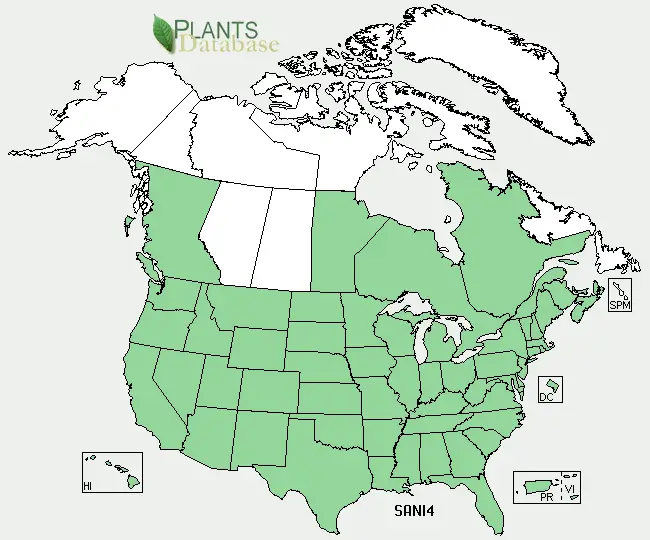
European Black Elderberry (Sambucus nigra) range. Distribution map courtesy of U. S. Department of Agriculture (USDA Natural Resources Service) and used in accordance with their policies.
American Elderberry (Sambucus canadensis). Sometimes the Latin name is listed as Sambucus nigra ssp. canadensis.
Description:
- USDA Plant Hardiness Zone: 3-8 (More information on hardiness zones).
- Soil pH: 5.5-7.5
- Plant Size: Shrub that can grow to over 3 meters (10 feet) tall
- Duration: Perennial that keeps regenerating from the mother plant by producing suckers
- Leaf Shape: Compound leaf, Odd Pinnate (one leaflet at the end of the leaf) with 5-9 leaflets.
- Leaf Phyllotaxis (Arrangement) on branch: Opposite
- Leaf Size: Each leaflet is up to 10 cm (4 inches) long and 5 cm (2 inches) wide
- Leaf Margin: Serrated (saw toothed edge)
- Leaf Notes: Sometimes the leaflets themselves are compound, most often the bottom pair. There may be two or three sub leaflets per leaflet
- Flowers: White, five petalled 5-6mm flowers on a corymb (type of cluster).
- Fruit: Ripe from late July to mid September. The clusters of ripe fruit HANG DOWN from the stems - this is important - do not eat what you think are American Elderberries if the cluster is upright, as it would be the European Dwarf Elder (Sambucus ebulus). 3-5 mm dark purple or black berry. Berry cluster stems are red.
- Bark: Young, grey with bumps, Mature, grey with vertical furrows or broken into deep plates.
- Habitat: Sunny locations, wet to dry soils, loose & open soils, not healthy on clay, prefers slightly acidic soils.
Web Resources:
- Recipe search on the web here (Google search) and here (Bing search).
- Pictures of the American Elderberry (Sambucus canadensis) on the web here (Google images) and here (Bing images).
- Interactive USDA distribution map and plant profile here.
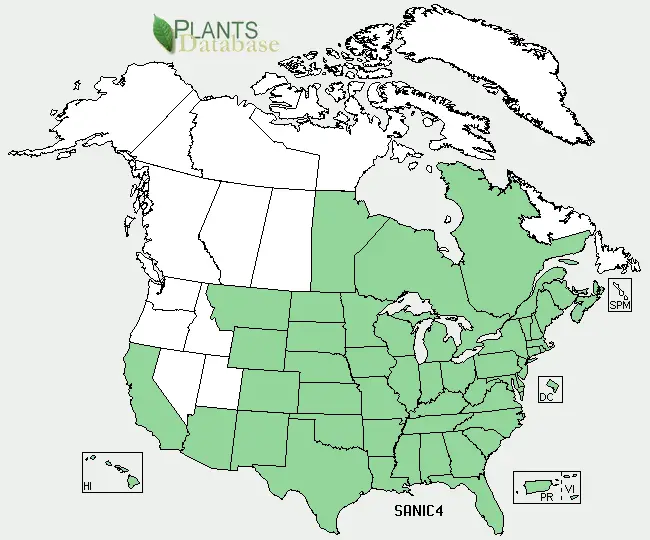
American Elderberry (Sambucus canadensis) range. Distribution map courtesy of U. S. Department of Agriculture (USDA Natural Resources Service) and used in accordance with their policies.
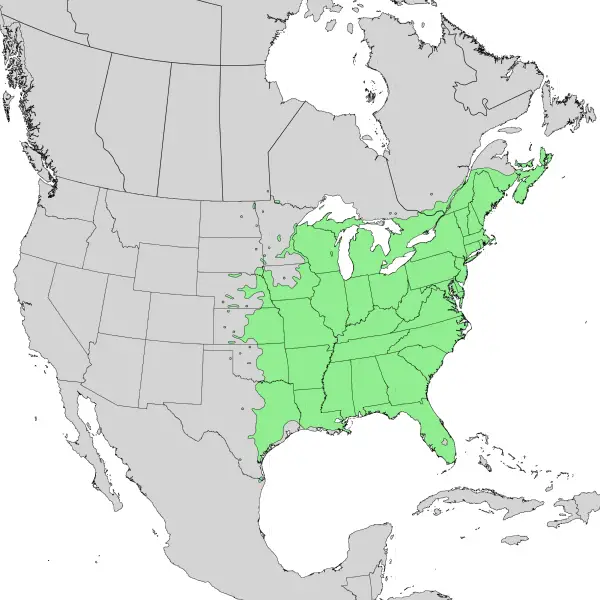
American Elderberry (Sambucus canadensis) range. Distribution map courtesy of the USGS Geosciences and Environmental Change Science Center, originally from "Atlas of United States Trees" by Elbert L. Little, Jr..
Red Elderberry (Sambucus racemosa) - Not Recommended.
I suggest not eating the berries from the Red Elderberry, as the seeds are apparently quite toxic. The berries have been used as food by native Americans, but they were very careful to never consume the seeds. If you choose to eat these berries, make sure they are cooked and make sure you do not consume the seeds. I will say, that in doing research on the berries of this plant, there is a lot of conflicting opinions on the toxicity. Some say the berries are toxic raw, some say they are OK raw if you don't eat the seeds, some say the berry and seeds are safe if cooked, some say the berries are safe if cooked as long as you strain out and don't eat the seeds. I don't bother with them at all, but if you choose to, go the safest route and eat only cooked with the seeds strained out.
Description:
- USDA Plant Hardiness Zone: 3-9 (More information on hardiness zones).
- Soil pH: 6.0-7.5
- Plant Size: 2-6 meter (6 to 20 feet) tall Shrub
- Duration: Perennial
- Leaf Shape: Compound leaf, Odd Pinnate (one leaflet at the end of the leaf) with 5-7 leaflets. The leaflets are Lanceolate
- Leaf Phyllotaxis (Arrangement) on branch: Opposite
- Leaf Size: Each compound leaf is up to 30 cm (12 inches) long, each leaflet is 5-10 cm (2 to 4 inches) long
- Leaf Margin: Serrated (saw toothed edge)
- Leaf Notes: When crushed the leaves give off a sort-of skunk cabbage like smell - not a pleasant smell
- Flowers: Creamy white in cone to pyramid shaped clusters
- Fruit: Bright red, clusters of many berries, clusters are upright, or hanging over a little - not fully upside down like the American and European Elderberries. 2-5 seeds per berry.
- Bark: Purplish red to reddish brown with raised bumps.
- Habitat: Neutral to alkaline soils and can live happily in calcium rich soils such as on limestone bedrock close to the surface, wide variety of conditions, but prefers open, loamy, moist soils, can tolerate some shade but prefers full sun
Web Resources:
- Pictures of the Red Elderberry (Sambucus racemosa) on the web here (Google images) and here (Bing images).
- Interactive USDA distribution map and plant profile here.
- The Biota of North America Program (BONAP) distribution map here. BONAP map color key here.
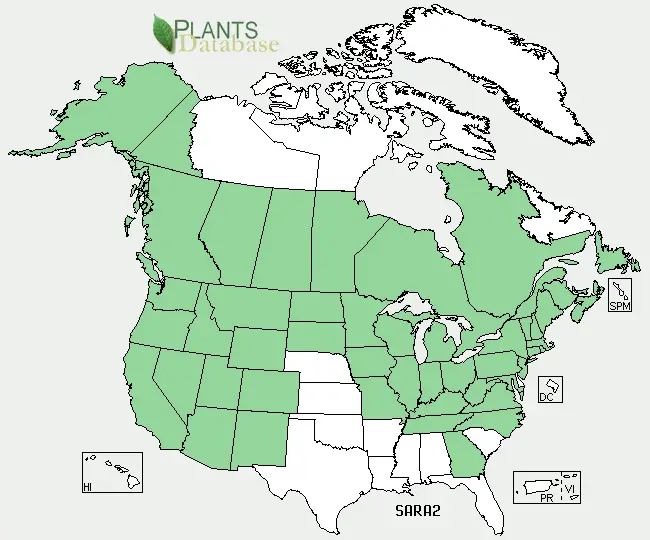
Red Elderberry (Sambucus racemosa) range. Distribution map courtesy of U. S. Department of Agriculture (USDA Natural Resources Service) and used in accordance with their policies.
European Dwarf Elder (Sambucus ebulus) - POISONOUS
Do Not eat the berries from this Elder, I've included it for identification purposes only so you will know it to not mix it up with the European or American Elderberry if out looking for ones to transplant or get seeds from.
The clusters of berries of this one look very much like the clusters of the edible European and American Elderberries, but there is one distinguishing feature: The ripe berry clusters from this plant are upright - that is, the berries are on top of the stem cluster, whereas with the edible European and American Elderberry, the clusters HANG DOWN on the stems. This plant is also smaller (it is rightly called the European DWARF Elderberry), and the leaves are different as well (narrower compared to length), but if you ever see what looks like ripe bunches of Elderberries and they are upright - not hanging down - don't eat them.
- Plant Size: 1-2 meters (3 to 6 1/2 feet) tall
- Duration: Perennial rhizome
- Leaf Shape: Compound leaf, Odd Pinnate, each leaflet is Lanceolate
- Leaf Phyllotaxis (Arrangement) on branch: Opposite
- Leaf Size: Compound leaf is 15-30 cm (6 to 12 inches) long
- Leaf Margin: Serrated (saw toothed edge)
- Leaf Notes: Leaves have a foul smell, sometimes each leaflet is compound, that is divided into 2 or more sub leaflets
- Flowers: on the top of the stem, a corymb of white to pinkish white flowers, the cluster of flowers is about 10-15 cm (4 to 6 inches) across
- Fruit: Cluster of upright black, shiny, 5-6 mm diameter berries
- Bark: The green stems and leaves turn red in the fall
- Habitat: On medium quality soils, forms areas of this plant from the spreading rhizome. Forest edges, clearings, sides of roads, ditches, fields.
Web Resources:
- Pictures of the European Dwarf Elder (Sambucus ebulus) on the web here (Google images) and here (Bing images).
- Interactive USDA distribution map and plant profile here.
- The Biota of North America Program (BONAP) distribution map here. BONAP map color key here.
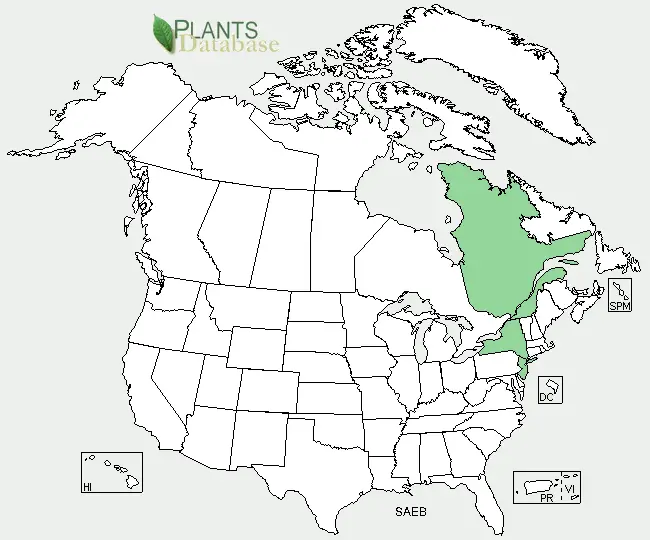
European Dwarf Elder (Sambucus Ebulus) range. Distribution map courtesy of U. S. Department of Agriculture (USDA Natural Resources Service) and used in accordance with their policies.
Search Wild Foods Home Garden & Nature's Restaurant Websites:
Share:
Why does this site have ads?
Originally the content in this site was a book that was sold through Amazon worldwide. However, I wanted the information to available to everyone free of charge, so I made this website. The ads on the site help cover the cost of maintaining the site and keeping it available.
Google + profile
